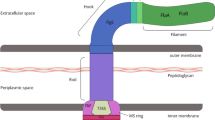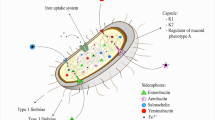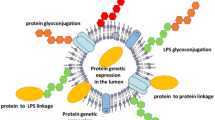Abstract
Enolases are generally thought of as cytoplasmic enzymes involved in glycolysis and gluconeogenesis. However, several bacteria have active forms of enolase associated with the cell surface and these proteins are utilized for functions other than central metabolism. Recently, a surface-associated protein produced by Lactobacillus gasseri ATCC 33323 with homology to enolase was found to inhibit the adherence of the sexually transmitted pathogen, Neisseria gonorrhoeae, to epithelial cells in culture. Here, we show that the protein is an active enolase in vitro. A recombinantly expressed, C-terminal His-tagged version of the protein, His6-Eno3, inhibited gonococcal adherence. Assays utilizing inhibitors of enolase enzymatic activity showed that this inhibitory activity required the substrate-binding site to be in an open conformation; however, the enolase enzymatic activity of the protein was not necessary for inhibition of gonococcal adherence. An L. gasseri strain carrying an insertional mutation in eno3 was viable, indicating that eno3 is not an essential gene in L. gasseri 33323. This observation, along with the results of the enzyme assays, is consistent with reports that this strain encodes more than one enolase. Here we show that the three L. gasseri genes annotated as encoding an enolase are expressed. The L. gasseri eno3 mutant exhibited reduced, but not abolished, inhibition of gonococcal adherence, which supports the hypothesis that L. gasseri inhibition of gonococcal adherence is a multifactorial process.




Similar content being viewed by others
References
Chhatwal GS (2002) Anchorless adhesins and invasins of Gram-positive bacteria: a new class of virulence factors. Trends Microbiol 10:205–208. doi:10.1016/S0966-842X(02)02351-X
Kainulainen V, Korhonen T (2014) Dancing to another tune: adhesive moonlighting proteins in bacteria. Biology 3:178–204
Bergmann S, Hammerschmidt S (2006) Versatility of pneumococcal surface proteins. Microbiology 152:295–303. doi:10.1099/mic.0.28610-0
Glenting J, Beck HC, Vrang A, Riemann H, Ravn P, Hansen AM, Antonsson M, Ahrné S, Israelsen H, Madsen S (2013) Anchorless surface associated glycolytic enzymes from Lactobacillus plantarum 299v bind to epithelial cells and extracellular matrix proteins. Microbiol Res 168:245–253. doi:10.1016/j.micres.2013.01.003
Henderson B, Martin A (2011) Bacterial virulence in the moonlight: multitasking bacterial moonlighting proteins are virulence determinants in infectious disease. Infect Immun 79:3476–3491. doi:10.1128/iai.00179-11
Huberts DHEW, van der Klei IJ (2010) Moonlighting proteins: an intriguing mode of multitasking. Biochim Biophys Acta 1803:520–525. doi:10.1016/j.bbamcr.2010.01.022
Schaumburg J, Diekmann O, Hagendorff P, Bergmann S, Rohde M, Hammerschmidt S, Jänsch L, Wehland J, Kärst U (2004) The cell wall subproteome of Listeria monocytogenes. Proteomics 4:2991–3006. doi:10.1002/pmic.200400928
Agarwal S, Kulshreshtha P, Bambah Mukku D, Bhatnagar R (2008) α-Enolase binds to human plasminogen on the surface of Bacillus anthracis. Biochim Biophys Acta 1784:986–994. doi:10.1016/j.bbapap.2008.03.017
Antikainen J, Kuparinen V, Lähteenmäki K, Korhonen TK (2007) Enolases from Gram-positive bacterial pathogens and commensal lactobacilli share functional similarity in virulence-associated traits. FEMS Immunol Med Microbiol 51:526–534. doi:10.1111/j.1574-695X.2007.00330.x
Knaust A, Weber MVR, Hammerschmidt S, Bergmann S, Frosch M, Kurzai O (2007) Cytosolic proteins contribute to surface plasminogen recruitment of Neisseria meningitidis. J Bacteriol 189:3246–3255. doi:10.1128/jb.01966-06
Pancholi V, Fischetti VA (1998) Alpha-enolase, a novel strong plasmin(ogen) binding protein on the surface of pathogenic streptococci. J Biol Chem 273:14503–14515
Sha J, Erova TE, Alyea RA, Wang S, Olano JP, Pancholi V, Chopra AK (2009) Surface-expressed enolase contributes to the pathogenesis of clinical isolate SSU of Aeromonas hydrophila. J Bacteriol 191:3095–3107. doi:10.1128/jb.00005-09
Donofrio FC, Calil ACA, Miranda ET, Almeida AMF, Benard G, Soares CP, Veloso SN, Soares CMdA, Mendes Giannini MJS (2009) Enolase from Paracoccidioides brasiliensis: isolation and identification as a fibronectin-binding protein. J Med Microbiol 58:706–713. doi:10.1099/jmm.0.003830-0
Jolodar A, Fischer P, Bergmann S, Büttner DW, Hammerschmidt S, Brattig NW (2003) Molecular cloning of an α-enolase from the human filarial parasite Onchocerca volvulus that binds human plasminogen. Biochim Biophys Acta 1627:111–120. doi:10.1016/S0167-4781(03)00083-6
Mundodi V, Kucknoor AS, Alderete JF (2008) Immunogenic and plasminogen-binding surface-associated alpha-enolase of Trichomonas vaginalis. Infect Immun 76:523–531. doi:10.1128/IAI.01352-07
Bergmann S, Rohde M, Preissner KT, Hammerschmidt S (2005) The nine residue plasminogen-binding motif of the pneumococcal enolase is the major cofactor of plasmin-mediated degradation of extracellular matrix, dissolution of fibrin and transmigration. Thromb Haemost 94:304–311. doi:10.1160/th05-05-0369
Lähteenmäki K, Edelman S, Korhonen TK (2005) Bacterial metastasis: the host plasminogen system in bacterial invasion. Trends Microbiol 13:79–85. doi:10.1016/j.tim.2004.12.003
Lähteenmäki K, Kuusela P, Korhonen TK (2000) Plasminogen activation in degradation and penetration of extracellular matrices and basement membranes by invasive bacteria. Methods 21:125–132. doi:10.1006/meth.2000.0983
Hurmalainen V, Edelman S, Antikainen J, Baumann M, Lähteenmäki K, Korhonen TK (2007) Extracellular proteins of Lactobacillus crispatus enhance activation of human plasminogen. Microbiology 153:1112–1122. doi:10.1099/mic.0.2006/000901-0
Castaldo C, Vastano V, Siciliano R, Candela M, Vici M, Muscariello L, Marasco R, Sacco M (2009) Surface displaced alfa-enolase of Lactobacillus plantarum is a fibronectin binding protein. Microb Cell Fact 8:14
Spurbeck RR, Arvidson CG (2008) Inhibition of Neisseria gonorrhoeae epithelial cell interactions by vaginal Lactobacillus species. Infect Immun 76:3124–3130. doi:10.1128/iai.00101-08 Author’s correction Infect Immun 80:3742. doi:10.1128/IAI.00788-12
Spurbeck RR, Arvidson CG (2010) Lactobacillus jensenii surface associated proteins inhibit Neisseria gonorrhoeae adherence to epithelial cells. Infect Immun 78:3103–3111. doi:10.1128/IAI.01200-09 Author’s correction Infect Immun 80:3743. doi:10.1128/IAI.00789-12
Segal E, Billyard E, So M, Storzbach S, Meyer TF (1985) Role of chromosomal rearrangement in N. gonorrhoeae pilus phase variation. Cell 40:293–300
Kellogg DS, Peacock WL, Deacon WE, Brown L, Pirkle CI (1963) Neisseria gonorrhoeae I.: virulence genetically linked to clonal variation. J Bacteriol 85:1274–1279
Whitehead K, Versalovic J, Roos S, Britton RA (2008) Genomic and genetic characterization of the bile stress response of probiotic Lactobacillus reuteri ATCC 55730. Appl Environ Microbiol 74:1812–1819. doi:10.1128/AEM.02259-07
Papagianni M, Avramidis N, Filioussis G (2007) High efficiency electrotransformation of Lactococcus lactis spp. lactis cells pretreated with lithium acetate and dithiothreitol. BMC Biotechnol 7:15. doi:10.1186/1472-6750-7-15
Makarova K, Slesarev A, Wolf Y et al (2006) Comparative genomics of the lactic acid bacteria. Proc Natl Acad Sci 103:15611–15616. doi:10.1073/pnas.0607117103
Pridmore RD, Berger B, Desiere F, Vilanova D, Barretto C, Pittet A-C, Zwahlen M-C, Rouvet M, Altermann E, Barrangou R, Mollet B, Mercenier A, Klaenhammer T, Arigoni F, Schell MA (2004) The genome sequence of the probiotic intestinal bacterium Lactobacillus johnsonii NCC 533. Proc Natl Acad Sci 101:2512–2517. doi:10.1073/pnas.0307327101
Lebioda L, Zhang E, Lewinski K, Brewer JM (1993) Fluoride inhibition of yeast enolase: crystal structure of the enolase-Mg(2+)-F(-)-P i complex at 2.6 A resolution. Proteins 16:219–225
Lebioda L, Stec B, Brewer JM, Tykarska E (1991) Inhibition of enolase: the crystal structures of enolase-Ca2(+)-2-phosphoglycerate and enolase-Zn2(+)-phosphoglycolate complexes at 2.2-A resolution. Biochemistry 30:2823–2827
Babbitt PC, Hasson MS, Wedekind JE, Palmer DRJ, Barrett WC, Reed GH, Rayment I, Ringe D, Kenyon GL, Gerlt JA (1996) The enolase superfamily: a general strategy for enzyme-catalyzed abstraction of the α-protons of carboxylic acids. Biochemistry 35:16489–16501. doi:10.1021/bi9616413
Candela M, Biagi E, Centanni M, Turroni S, Vici M, Musiani F, Vitali B, Bergmann S, Hammerschmidt S, Brigidi P (2009) Bifidobacterial enolase, a cell surface receptor for human plasminogen involved in the interaction with the host. Microbiology 155:3294–3303. doi:10.1099/mic.0.028795-0
Lopez-Alemany R, Suelves M, Diaz-Ramos A, Vidal B, Munoz-Canoves P (2005) Alpha-enolase plasminogen receptor in myogenesis. Front Biosci 10:30–36
Wilson M (2005) Microbial inhabitants of humans: their ecology and role in health and disease. The Press Syndicate of the University of Cambridge, Cambridge
Sanchez B, Schmitter JM, Urdaci MC (2009) Identification of novel proteins secreted by Lactobacillus plantarum that bind to mucin and fibronectin. J Mol Microbiol Biotechnol 17:158–162. doi:10.1159/000233579
Owen DH, Katz DF (1999) A vaginal fluid simulant. Contraception 59:91–95
Wagner G, Levin RJ (1980) Electrolytes in vaginal fluid during the menstrual cycle of coitally active and inactive women. J Reprod Fertil 60:17–27
Tunio SA, Oldfield NJ, Berry A, Ala’aldeen DA, Wooldridge KG, Turner DP (2010) The moonlighting protein fructose-1, 6-bisphosphate aldolase of Neisseria meningitidis: surface localization and role in host cell adhesion. Mol Microbiol 76:605–615. doi:10.1111/j.1365-2958.2010.07098.x
Antikainen J, Kupannen V, Lähteenmäki K, Korhonen TK (2007) pH-dependent association of enolase and glyceraldehyde-3-phosphate dehydrogenase of Lactobacillus crispatus with the cell wall and lipoteichoic acids. J Bacteriol 189:4539–4543. doi:10.1128/jb.00378-07
Bergmann S, Rohde M, Chhatwal GS, Hammerschmidt S (2001) α-Enolase of Streptococcus pneumoniae is a plasmin(ogen)-binding protein displayed on the bacterial cell surface. Mol Microbiol 40:1273–1287. doi:10.1046/j.1365-2958.2001.02448.x
Esgleas M, Li Y, Hancock MA, Harel J, Dubreuil JD, Gottschalk M (2008) Isolation and characterization of α-enolase, a novel fibronectin-binding protein from Streptococcus suis. Microbiology 154:2668–2679. doi:10.1099/mic.0.2008/017145-0
Burnham C-AD, Shokoples SE, Tyrrell GJ (2005) Phosphoglycerate kinase inhibits epithelial cell invasion by group B streptococci. Microb Pathog 38:189–200. doi:10.1016/j.micpath.2005.02.002
Alvarez RA, Blaylock MW, Baseman JB (2003) Surface localized glyceraldehyde-3-phosphate dehydrogenase of Mycoplasma genitalium binds mucin. Mol Microbiol 48:1417–1425. doi:10.1046/j.1365-2958.2003.03518.x
Egea L, Aguilera L, Giménez R, Sorolla MA, Aguilar J, Badía J, Baldoma L (2007) Role of secreted glyceraldehyde-3-phosphate dehydrogenase in the infection mechanism of enterohemorrhagic and enteropathogenic Escherichia coli: interaction of the extracellular enzyme with human plasminogen and fibrinogen. Int J Biochem Cell Biol 39:1190–1203. doi:10.1016/j.biocel.2007.03.008
Kinoshita H, Wakahara N, Watanabe M, Kawasaki T, Matsuo H, Kawai Y, Kitazawa H, Ohnuma S, Miura K, Horii A, Saito T (2008) Cell surface glyceraldehyde-3-phosphate dehydrogenase (GAPDH) of Lactobacillus plantarum LA 318 recognizes human A and B blood group antigens. Res Microbiol 159:685–691. doi:10.1016/j.resmic.2008.07.005
Madureira P, Baptista M, Vieira M, Magalhães V, Camelo A, Oliveira L, Ribeiro A, Tavares D, Trieu-Cuot P, Vilanova M, Ferreira P (2007) Streptococcus agalactiae GAPDH is a virulence-associated immunomodulatory protein. J Immunol 178:1379–1387. doi:10.4049/jimmunol.178.3.1379
Modun B, Morrissey J, Williams P (2000) The staphylococcal transferrin receptor: a glycolytic enzyme with novel functions. Trends Microbiol 8:231–237. doi:10.1016/S0966-842X(00)01728-5
Terao Y, Yamaguchi M, Hamada S, Kawabata S (2006) Multifunctional glyceraldehyde-3-phosphate dehydrogenase of Streptococcus pyogenes is essential for evasion from neutrophils. J Biol Chem 281:14215–14223. doi:10.1074/jbc.M513408200
Seidler N (2013) Multiple binding partners. In: GAPDH: biological properties and diversity. Advances in Experimental Medicine and Biology. Springer, Netherlands, pp 249–267. doi:10.1007/978-94-007-4716-6_8
McGee ZA, Johnson AP, Taylor-Robinson D (1981) Pathogenic mechanisms of Neisseria gonorrhoeae: observations on damage to human Fallopian tubes in organ culture by gonococci of colony type 1 or type 4. J Infect Dis 143:413–422
Merz AJ, Rifenbery DB, Arvidson CG, So M (1996) Traversal of a polarized epithelium by pathogenic Neisseriae: facilitation by type IV pili and maintenance of epithelial barrier function. Mol Med 2:745–754
Swanson J (1973) Studies on gonococcus infection. IV. Pili: their role in attachment of gonococci to tissue culture cells. J Exp Med 137:571–589
Harris PT, Raghunathan K, Spurbeck RR, Arvidson CG, Arvidson DN (2010) Expression, purification, crystallization and preliminary X-ray studies of Lactobacillus jensenii enolase. Acta Crystallogr Sect F Struct Biol Cryst Commun 66:938–940. doi:10.1107/S1744309110022748 Addenda and Errata (2013) Acta Crystallogr Sect F Struct Biol Cryst Commun 69:1070
Raghunathan K, Harris PT, Spurbeck RR, Arvidson CG, Arvidson DN (2014) Crystal structure of an efficacious gonococcal adherence inhibitor: an enolase from Lactobacillus gasseri. FEBS Lett 588:2212–2216. doi:10.1016/j.febslet.2014.05.020
Navarro MVdAS, Gomes Dias SM, Mello LV, da Silva Giotto MT, Gavalda S, Blonski C, Garratt RC, Rigden DJ (2007) Structural flexibility in Trypanosoma brucei enolase revealed by X-ray crystallography and molecular dynamics. FEBS J 274:5077–5089. doi:10.1111/j.1742-4658.2007.06027.x
Wedekind JE, Poyner RR, Reed GH, Rayment I (1994) Chelation of serine 39 to Mg2+ latches a gate at the active site of enolase: structure of the bis(Mg2+) complex of yeast enolase and the intermediate analog phosphonoacetohydroxamate at 2.1-A resolution. Biochemistry 33:9333–9342
Sims PA, Menefee AL, Larsen TM, Mansoorabadi SO, Reed GH (2006) Structure and catalytic properties of an engineered heterodimer of enolase composed of one active and one inactive subunit. J Mol Biol 355:422–431. doi:10.1016/j.jmb.2005.10.050
Bolan GA, Sparling PF, Wasserheit JN (2012) The emerging threat of untreatable gonococcal infection. N Engl J Med 366:485–487
Acknowledgments
We would like to thank Dr. Robert Britton for providing the plasmids pORI19 and pVE6007 for the insertional mutagenesis system, and for his advice on mutagenesis in lactobacilli. We would also like to thank Dr. Lin Tao for providing protocols and advice for electroporation of L. gasseri. Finally, we would like to thank Dr. Eric Carter for his advice on enzyme kinetics and Dr. Robert Hausinger for critical reading of the manuscript.
Conflict of interest
R. R. Spurbeck, P. T. Harris, K. Raghunathan, D. N. Arvidson, and C. G. Arvidson declare that they have no conflicts of interest.
Author information
Authors and Affiliations
Corresponding author
Electronic supplementary material
Below is the link to the electronic supplementary material.
Rights and permissions
About this article
Cite this article
Spurbeck, R.R., Harris, P.T., Raghunathan, K. et al. A Moonlighting Enolase from Lactobacillus gasseri does not Require Enzymatic Activity to Inhibit Neisseria gonorrhoeae Adherence to Epithelial Cells. Probiotics & Antimicro. Prot. 7, 193–202 (2015). https://doi.org/10.1007/s12602-015-9192-8
Published:
Issue Date:
DOI: https://doi.org/10.1007/s12602-015-9192-8




